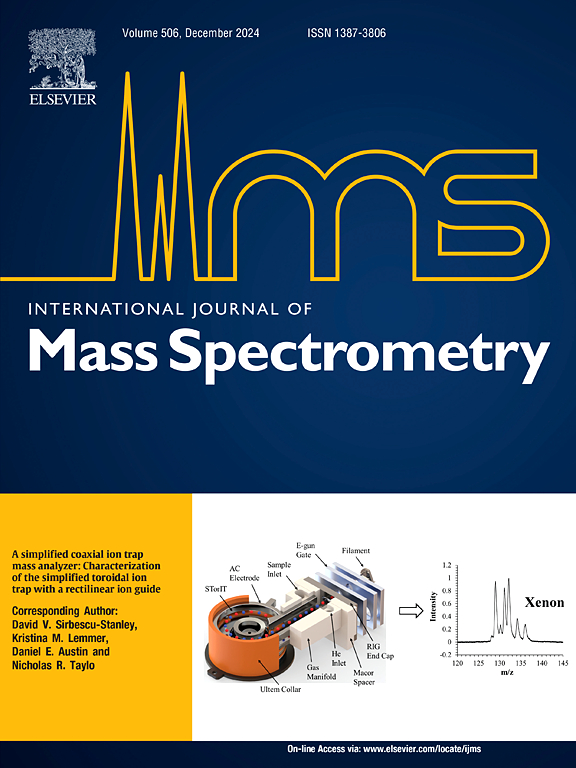揭示丝氨酸和苏氨酸处自由基定向 xn-H2O 解离的有利条件
IF 1.7
3区 化学
Q3 PHYSICS, ATOMIC, MOLECULAR & CHEMICAL
引用次数: 0
摘要
在串联质谱分析方法中,自由基定向解离(RDD)对分子结构具有独特的敏感性,因为观察到的裂解位置和类型是由自由基迁移倾向决定的。虽然以前已经解释过许多 RDD 断裂途径的基本化学原理,但还没有详细研究过专门发生在丝氨酸和苏氨酸残基上的 xn-H2O 片段离子。产生这种片段类型本质上需要两个解离事件,一个是失水,另一个是裂解肽骨。相对于需要单次裂解的途径,双重解离通常是不受欢迎的,但 xn-H2O 片段离子在 RDD 图谱中却很丰富。为了了解为什么这种裂解途径是有利的,我们结合使用了计算化学和对具有各种共价修饰的肽进行的实验。我们的研究结果探讨了该机制每个步骤中自由基的能量、位置和迁移,揭示了该机制的有利之处在于所需的自由基中间体的稳定性以及连接它们的低能量途径。最终,xn-H2O 离子的丰富性及其在 Ser/Thr 独家生成的选择性为 RDD 实验提供了高价值的序列信息。本文章由计算机程序翻译,如有差异,请以英文原文为准。

Unravelling the favorability of radical-directed xn-H2O dissociation at serine and threonine
Among tandem-mass-spectrometry approaches, radical-directed dissociation (RDD) is uniquely sensitive to molecular structure because the location and types of cleavage observed are dictated by radical migration propensities. Although the underlying chemistry for many RDD fragmentation pathways has been previously explained, xn-H2O fragment ions that occur exclusively at serine and threonine residues, have not been examined in detail. Creation of this fragment type inherently requires two dissociation events, one to lose water and another to cleave the peptide backbone. Double dissociations are typically disfavored relative to pathways requiring a single cleavage, yet xn-H2O fragment ions are abundant in RDD spectra. To understand why this fragmentation pathway is favorable, we used a combination of computational chemistry and experiments on peptides with a variety of covalent modifications. Our results explore the energetics, location, and migration of the radical in each step of the mechanism, revealing that favorability can be attributed to the stability of the required radical intermediates and access to low-energy pathways connecting them. Ultimately, the abundant nature of xn-H2O ions and the selectivity associated with their exclusive generation at Ser/Thr provides high value sequence information in RDD experiments.
求助全文
通过发布文献求助,成功后即可免费获取论文全文。
去求助
来源期刊
CiteScore
3.60
自引率
5.60%
发文量
145
审稿时长
71 days
期刊介绍:
The journal invites papers that advance the field of mass spectrometry by exploring fundamental aspects of ion processes using both the experimental and theoretical approaches, developing new instrumentation and experimental strategies for chemical analysis using mass spectrometry, developing new computational strategies for data interpretation and integration, reporting new applications of mass spectrometry and hyphenated techniques in biology, chemistry, geology, and physics.
Papers, in which standard mass spectrometry techniques are used for analysis will not be considered.
IJMS publishes full-length articles, short communications, reviews, and feature articles including young scientist features.

 求助内容:
求助内容: 应助结果提醒方式:
应助结果提醒方式:


